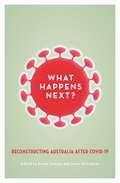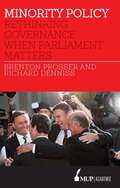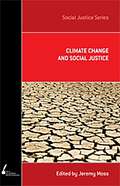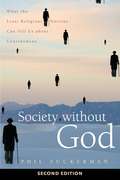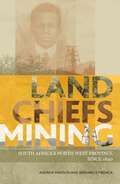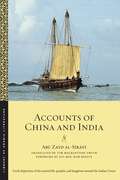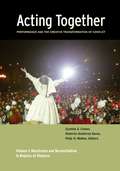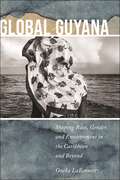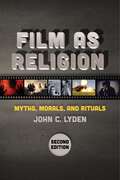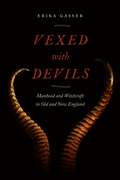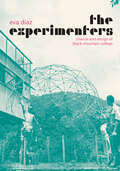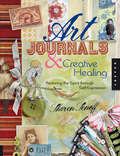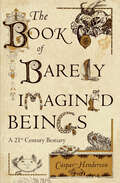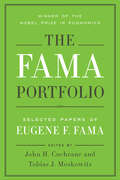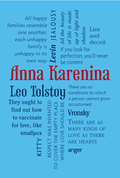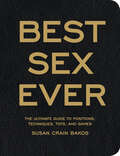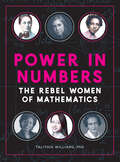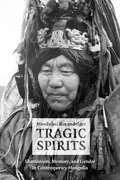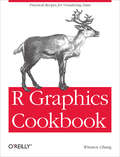- Table View
- List View
What Happens Next?: Reconstructing Australia after COVID-19
by Janet McCalman Emma DawsonLong before the COVID-19 pandemic shut down the global economy, a reset to serve the wellbeing of people and the planet was plainly needed. As Australia rebuilds, after the immediate health crisis has passed, it must be with the explicit purpose of constructing an economically and ecologically sustainable world. After the Great Depression and the Second World War, economic thinking was transformed across the Anglosphere, with a determination to create a more equitable society and support every child, regardless of background, to achieve their full potential. Australia's leaders reshaped our economy through a determined and coordinated program of post-war reconstruction. Their reforms set us up for decades of prosperity and the creation of perhaps the most prosperous and stable society on earth. With contributions from some of Australia's most respected academics and leading thinkers, What Happens Next? sets out a progressive, reforming agenda to tackle the twin crises of climate change and inequality. It provides a framework through which our collective effort can be devoted to improving the lives of all Australians, and the sustainability of the world in which we live.
Minority Policy: Rethinking governance when parliament matters
by Richard Denniss Brenton ProsserTopical and up to the minute, Minority Policy: Rethinking governance when parliament matters explores the influence of marginal parliamentarians both within the major parties and on the cross benches in the formations of contemporary public policy.Despite Australia having minority government in some form for almost three decades, in theoretical and popular terms it seems that this nation has not yet come to terms with minority as the new norm. Further, prominent policy cycle theory overlooks the subtle but significant influence of marginal parliamentarians on public policy. This book argues that these influences not only have important implications for the outcomes of public policy, but also the work of policy scholars, departmental policy makers and policy advocates.Drawing on the experiences of two former policy advisers who have worked at the coalface of policy-making, as well as on examples from the last two parliaments, Minority Policy takes the discussion up to and beyond the introduction of the new Senate in July 2014 to take in the significant impact of this much more complex Upper House.
Climate Change and Social Justice
by Jeremy MossThe impacts of climate change can already be felt in society and on the Earth itself. As new evidence of the environmental impact of climate change is constantly emerging, we are forced to confront the significance of our political decisions about who will pay the price of responding to a changing climate. In the rush to avoid or reduce the repercussions of climate change, we need to ensure that the burden is evenly distributed or run the risk of creating injustice. Climate Change and Social Justice demonstrates that the problem of how to distribute the costs of climate change is fundamentally a problem of justice. If we ignore the concerns addressed this book, the additional burdens of climate change will fall on the poor and vulnerable. Jeremy Moss brings together today's key thinkers in climate research, including Peter Singer, Ross Garnaut and David Karoly, to respond to these important issues.
History Of Australia (Volumes 3 & 4): From 1824 to 1888
by Manning ClarkManning Clark's six-volume history is one of the masterpieces of Australian writing. It is also one of the most passionately debated visions of Australian history, in which the struggle to realise an Australian nation is played out on an epic scale. A History of Australia: 1824-1888, takes the story of Australia through the momentous discovery of gold and the separation of Victoria from New South Wales, to the centenary of the coming of European civilisation to Australia on 26 January 1888. The story is one of destruction as well as construction-the destruction of the Aborigines and the construction of an essentially English bourgeois society and the taming of an alien and seemingly sterile land. This is not a general Australian history-it does not attempt to cover all aspects-and it is not a definitive or quantitative analysis. It is a work of art, a living and breathing account of the remaking of a primitive continent, history come alive.
Society without God, Second Edition: What the Least Religious Nations Can Tell Us about Contentment
by Phil ZuckermanAn updated edition showcasing the social health of the least religious nations in the worldReligious conservatives around the world often claim that a society without a strong foundation of faith would necessarily be an immoral one, bereft of ethics, values, and meaning. Indeed, the Christian Right in the United States has argued that a society without God would be hell on earth.In Society without God, Second Edition sociologist Phil Zuckerman challenges these claims. Drawing on fieldwork and interviews with more than 150 citizens of Denmark and Sweden, among the least religious countries in the world, he shows that, far from being inhumane, crime-infested, and dysfunctional, highly secular societies are healthier, safer, greener, less violent, and more democratic and egalitarian than highly religious ones.Society without God provides a rich portrait of life in a secular society, exploring how a culture without faith copes with death, grapples with the meaning of life, and remains content through everyday ups and downs. This updated edition incorporates new data from recent studies, updated statistics, and a revised Introduction, as well as framing around the now more highly developed field of secular studies. It addresses the dramatic surge of irreligion in the United States and the rise of the “nones,” and adds data on societal health in specific US states, along with fascinating context regarding which are the most religious and which the most secular.
Land, Chiefs, Mining: South Africa's North West Province since 1840
by Andrew Manson Bernard MbengaLand, Chiefs, Mining explores aspects of the experience of the Batswana in the thornveld and bushveld regions of the North-West Province, shedding light on defi ning issues, moments and individuals in this lesser known region of South Africa. Some of the focuses are: an important Tswana kgosi (chief ), Moiloa II of the Bahurutshe; responses to and participation in the South African War and its aftermath, 1899-1907; land acquisition; economic and political conditions in the reserves; resistance to Mangope’s Bophuthatswana; the impact of game parks and the Sun City resort; rural resistance and the liberation struggle; and African reaction to the platinum mining revolution. Written in a direct and accessible style, and illustrated with photographs and maps, the book provides an understanding, for a general reader ship, of the region and its recent history. At the same time it opens up avenues for further research. The authors, Andrew Manson and Bernard Mbenga, both based at North-West University, Mahikeng Campus, have, for some thirty years, been studying and writing on the region’s past.
Accounts of China and India: Accounts Of China And India And Mission To The Volga (Library of Arabic Literature #55)
by Abū Zayd al-SīrāfīThe ninth and tenth centuries witnessed the establishment of a substantial network of maritime trade across the Indian Ocean, providing the real-life background to the Sinbad tales. An exceptional exemplar of Arabic travel writing, Accounts of China and India is a compilation of reports and anecdotes about the lands and peoples of this diverse territory, from the Somali headlands of Africa to the far eastern shores of China and Korea. Traveling eastward, we discover a vivid human landscape—from Chinese society to Hindu religious practices—as well as a colorful range of natural wilderness—from flying fish to Tibetan musk-deer and Sri Lankan gems. The juxtaposed accounts create a kaleidoscope of a world not unlike our own, a world on the road to globalization. In its ports, we find a priceless cargo of information. Here are the first foreign descriptions of tea and porcelain, a panorama of unusual social practices, cannibal islands, and Indian holy men—a marvelous, mundane world, contained in the compass of a novella.An English-only edition.
Women Doing Life: Gender, Punishment and the Struggle for Identity
by Lora Bex LempertThe carceral experiences of women serving life sentences. 2017 Michigan Notable Book Selection presented by The Detroit Free PressHow do women – mothers, daughters, aunts, nieces and grandmothers – make sense of judgment to a lifetime behind bars? In Women Doing Life, Lora Bex Lempert presents a typology of the ways that life-sentenced women grow and self-actualize, resist prison definitions, reflect on and “own” their criminal acts, and ultimately create meaningful lives behind prison walls. Looking beyond the explosive headlines that often characterize these women as monsters, Lempert offers rare insight into this vulnerable, little studied population. Her gendered analysis considers the ways that women “do crime” differently than men and how they have qualitatively different experiences of imprisonment than their male counterparts. Through in-depth interviews with 72 women serving life sentences in Michigan, Lempert brings these women back into the public arena, drawing analytical attention to their complicated, contradictory, and yet compelling lives.Women Doing Life focuses particular attention on how women cope with their no-exit sentences and explores how their lifetime imprisonment catalyzes personal reflection, accountability for choices, reconstruction of their stigmatized identities, and rebuilding of social bonds. Most of the women in her study reported childhoods in environments where violence and disorder were common; many were victims before they were offenders. Lempert vividly illustrates how, behind the prison gates, life-serving women can develop lives that are meaningful, capable and, oftentimes, even ordinary. Women Doing Life shows both the scope and the limit of human possibility available to women incarcerated for life.
This Is Our School!: Race and Community Resistance to School Reform
by Hava Rachel GordonHow local educational justice movements wrestle with neoliberal school reformParents, educators, and activists are passionately fighting to improve public schools around the country. In This Is Our School! Hava Rachel Gordon takes us inside these fascinating school reform movements, exploring their origins, aims, and victories as they work to build a better future for our education system.Focusing on a school district in Denver, Colorado, Gordon takes a look at different coalitions within the school reform movement, as well as the surprising competition that arises between them. Drawing on over eighty interviews and ethnographic research, she explores how these groups vie for power, as well as the role that race, class, and gentrification play in shaping their successes and failures, strategies and structures. Gordon shows us what happens when people mobilizefrom the ground up and advocate for educational change. This Is Our School! gives us an inside look at the diverse voices within the school reform movement, each of which plays an important role in the fight to improve public education.
Citizens but Not Americans: Race and Belonging among Latino Millennials (Latina/o Sociology #8)
by Nilda Flores-GonzálezAn exploration of how race shapes Latino millennials’ notions of national belonging Latino millennials constitute the second largest segment of the millennial population. By sheer numbers they will inevitably have a significant social, economic, and political impact on U.S. society. Beyond basic demographics, however, not much is known about how they make sense of themselves as Americans.In Citizens but Not Americans,Nilda Flores-González examines how Latino millennials understand race, experience race, and develop notions of belonging. Based on nearly one hundred interviews, Flores-González argues that though these young Latina/os are U.S. citizens by birth, they do not feel they are part of the “American project,” and are forever at the margins looking in. The book provides an inside look at how characteristics such as ancestry, skin color, social class, gender, language and culture converge and shape these youths’ feelings of belonging as they navigate everyday racialization. The voices of Latino millennials reveal their understanding of racialization along three dimensions—as an ethno-race, as a racial middle and as ‘real’ Americans. Using familiar tropes, these youths contest the othering that negates their Americanness while constructing notions of belonging that allow them to locate themselves as authentic members of the American national community.Challenging current thinking about race and national belonging, Citizens but Not Americans significantly contributes to our understanding of the Latino millennial generation and makes a powerful argument about the nature of race and belonging in the U.S.
Acting Together I: Resistance and Reconciliation in Regions of Violence
by Edited by Cynthia E. Cohen, Roberto Gutiérrez Varea, and Polly O. WalkerCourageous artists working in conflict regions describe exemplary peacebuilding performances and groundbreaking theory on performance for transformation of violence.Acting Together: Performance and the Creative Transformation of Conflict is a two-volume work describing peacebuilding performances in regions beset by violence and internal conflicts. Volume I: Resistance and Reconciliation in Regions of Violence, emphasizes the role theatre and ritual play both in the midst and in the aftermath of direct violence, while Volume II: Building Just and Inclusive Communities, focuses on the transformative power of performance in regions fractured by "subtler" forms of structural violence and social exclusion.Volume I: Resistance and Reconciliation in Regions of Violence focuses on the role theatre and ritual play both in the midst and in the aftermath of violence. The performances highlighted in this volume nourish and restore capacities for expression, communication, and transformative action, and creatively support communities in grappling with conflicting moral imperatives surrounding questions of justice, memory, resistance, and identity. The individual chapters, written by scholars, conflict resolution practitioners, and artists who work directly with the communities involved, offer vivid firsthand accounts and analyses of traditional and nontraditional performances in Serbia, Uganda, Sri Lanka, Palestine, Israel, Argentina, Peru, India, Cambodia, Australia, and the United States.Complemented by a website of related materials, a documentary film, Acting Together on the World Stage, that features clips and interviews with the curators and artists, and a toolkit, or "Tools for Continuing the Conversation," that is included with the documentary as a second disc, this book will inform and inspire socially engaged artists, cultural workers, peacebuilding scholars and practitioners, human rights activists, students of peace and justice studies, and whoever wishes to better understand conflict and the power of art to bring about social change.The Acting Together project is born of a collaboration between Theatre Without Borders and the Program in Peacebuilding and the Arts at the International Center for Ethics, Justice, and Public Life at Brandeis University. The two volumes are edited by Cynthia E. Cohen, director of the aforementioned program and a leading figure in creative approaches to coexistence and reconciliation; Roberto Gutierrez Varea, an award-winning director and associate professor at the University of San Francisco; and Polly O. Walker, director of Partners in Peace, an NGO based in Brisbane, Australia..
Global Guyana: Shaping Race, Gender, and Environment in the Caribbean and Beyond
by Oneka LaBennettExposes the global threat of environmental catastrophe and the forms of erasure that structure Caribbean women’s lives in the overlooked nation of GuyanaPreviously ranked among the hemisphere’s poorest countries, Guyana is becoming a global leader in per capita oil production, a shift which promises to profoundly transform the nation. This sea change presents a unique opportunity to dissect both the environmental impacts of modern-world resource extraction and the obscured yet damaging ways in which intersectional race and gender formations circumscribe Caribbean women’s lives.Drawing from archival research and oral history, and examining mass-mediated flashpoints across the African and Indian diasporas—including Rihanna’s sonic routes, ethnic conflict reportage, HBO’s Lovecraft Country, and Netflix’s Indian Matchmaking—Global Guyana repositions this marginalized nation as a nexus of social and economic activity which drives popular culture and ideas about sexuality while reshaping the geopolitical and literal topography of the Caribbean region. Oneka LaBennett employs the powerful analytic of the pointer broom to disentangle the symbiotic relationship between Guyanese women’s gendered labor and global racial capitalism. She illuminates how both oil extraction and sand export are implicated in a well-established practice of pillaging the Caribbean’s natural resources while masking the ecological consequences that disproportionately affect women and children.Global Guyana uncovers how ecological erosion and gendered violence are entrenched in extractive industries emanating from this often-effaced but pivotal country. Sounding the alarm on the portentous repercussions that ambitious development spells out for the nation’s people and its geographical terrain, LaBennett issues a warning for all of us about the looming threat of global environmental calamity.
Film as Religion, Second Edition: Myths, Morals, and Rituals
by John C. LydenArgues that popular films perform a religious function in our culture The first edition of Film as Religion was one of the first texts to develop a framework for the analysis of the religious function of films for audiences. Like more formal religious institutions, films can provide us with ways to view the world and the values to confront it. Lyden argues that the cultural influence of films is analogous to that of religions, so that films can be understood as representing a “religious” worldview in their own right. Thoroughly updating his examples, Lyden examines a range of film genres and individual films, from The Godfather to The Hunger Games to Frozen, to show how film can function religiously.
Vexed with Devils: Manhood and Witchcraft in Old and New England (Early American Places #6)
by Erika GasserStories of witchcraft and demonic possession from early modern England through the last official trials in colonial New EnglandThose possessed by the devil in early modern England usually exhibited a common set of symptoms: fits, vomiting, visions, contortions, speaking in tongues, and an antipathy to prayer. However, it was a matter of interpretation, and sometimes public opinion, if these symptoms were visited upon the victim, or if they came from within. Both early modern England and colonial New England had cases that blurred the line between witchcraft and demonic possession, most famously, the Salem witch trials. While historians acknowledge some similarities in witch trials between the two regions, such as the fact that an overwhelming majority of witches were women, the histories of these cases primarily focus on local contexts and specifics. In so doing, they overlook the ways in which manhood factored into possession and witchcraft cases. Vexed with Devils is a cultural history of witchcraft-possession phenomena that centers on the role of men and patriarchal power. Erika Gasser reveals that witchcraft trials had as much to do with who had power in the community, to impose judgement or to subvert order, as they did with religious belief. She argues that the gendered dynamics of possession and witchcraft demonstrated that contested meanings of manhood played a critical role in the struggle to maintain authority. While all men were not capable of accessing power in the same ways, many of the people involved—those who acted as if they were possessed, men accused of being witches, and men who wrote possession propaganda—invoked manhood as they struggled to advocate for themselves during these perilous times. Gasser ultimately concludes that the decline of possession and witchcraft cases was not merely a product of change over time, but rather an indication of the ways in which patriarchal power endured throughout and beyond the colonial period. Vexed with Devils reexamines an unnerving time and offers a surprising new perspective on our own, using stories and voices which emerge from the records in ways that continue to fascinate and unsettle us.
The Experimenters: Chance and Design at Black Mountain College
by Eva DíazIn the years immediately following World War II, Black Mountain College, an unaccredited school in rural Appalachia, became a vital hub of cultural innovation. Practically every major artistic figure of the mid-twentieth century spent some time there: Merce Cunningham, Ray Johnson, Franz Kline, Willem and Elaine de Kooning, Robert Motherwell, Robert Rauschenberg, Dorothea Rockburne, Aaron Siskind, Cy Twombly—the list goes on and on. Yet scholars have tended to view these artists’ time at the College as little more than prologue, a step on their way to greatness. With The Experimenters, Eva Díaz reveals the importance of Black Mountain College—and especially of three key teachers, Josef Albers, John Cage, and R. Buckminster Fuller—to be much greater than that. Díaz’s focus is on experimentation. Albers, Cage, and Fuller, she shows, taught new models of art making that favored testing procedures rather than personal expression. These methodologies represented incipient directions for postwar art practice, elements of which would be sampled, and often wholly adopted, by Black Mountain students and subsequent practitioners. The resulting works, which interrelate art and life in a way that imbues these projects with crucial relevance, not only reconfigured the relationships among chance, order, and design—they helped redefine what artistic practice was, and could be, for future generations. Offering a bold, compelling new angle on some of the most widely studied creative figures of modern times, The Experimenters does nothing less than rewrite the story of art in the mid-twentieth century.
Art Journals & Creative Healing: Restoring the Spirit through Self-Expression
by Sharon SoneffInspiration and guidance for creating journals or scrapbooks for self-healing and inner strength while managing life’s difficult moments.In follow up to Faith Books & Spiritual Journaling, author Sharon Soneff shows that there is a richer, deeper reward to creative journals beyond the beauty they supply. In this new volume, Art Journals & Creative Healing, she demonstrates with real excerpts from artistic journals that the process of journaling can be a tool in navigating through some of life’s more challenging seasons, as well as a tool to support personal growth and achievement. Complex human experiences are treated with dignity and sensitivity, and will inspire readers dealing with their own issues. Hope, growth, and healing are at the center of each work.Additionally, the ideas, artistic approaches, and resources provided by the author and numerous contributing artists will help the reader with creative ideas for working through various situations through their reflective and artistic journal keeping. Through a marriage of beautiful imagery, uplifting quotations, and other rich sources, Art Journals & Creative Healing offers its audience a full-bodied artistic experience, along with journaling worksheets and journal prompts to help readers get started with their own journals. Specific topics addressed include using mediums as metaphors, journaling for cathartic expression, gaining wisdom through introspection, finding strength in the midst of suffering, and finding beauty in pain. Art Journals & Creative Healing is a supportive and encouraging text offered as a creative companion for overcoming the challenges of life.
The Book of Barely Imagined Beings: A 21st Century Bestiary
by Caspar Henderson“Caspar Henderson takes us on an eye-opening tour of real animals that no sane human could ever have invented.” —Frans de Waal, New York Times–bestselling authorWith The Book of Barely Imagined Beings, Caspar Henderson offers readers a fascinating, beautifully produced modern-day menagerie. But whereas medieval bestiaries were often based on folklore and myth, the creatures that abound in Henderson’s book—from the axolotl to the zebrafish—are, with one exception, very much with us, albeit sometimes in depleted numbers. The Book of Barely Imagined Beings transports readers to a world of real creatures that seem as if they should be made up—that are somehow more astonishing than anything we might have imagined. The yeti crab, for example, uses its furry claws to farm the bacteria on which it feeds. The waterbear, meanwhile, is among nature’s “extreme survivors,” able to withstand a week unprotected in outer space. These and other strange and surprising species invite readers to reflect on what we value—or fail to value—and what we might change.A powerful combination of wit, cutting-edge natural history, and philosophical meditation, The Book of Barely Imagined Beings is an infectious and inspiring celebration of the sheer ingenuity and variety of life in a time of crisis and change.“The Book of Barely Imagined Beings is one that Pliny would have envied, Darwin applauded, and Borges relished . . . In these days of doom and gloom, I can think of nothing more rejoicing than Caspar Henderson’s magical book.” —Alberto Manguel, author of A History of Reading“Magnificent, bravura, beautiful and astoundingly interesting.” —The Sunday Times“Spell-binding, brilliantly executed, extraordinary.” —The Guardian
The Fama Portfolio: Selected Papers of Eugene F. Fama
by Eugene F. FamaThis collection of the most influential work of the Nobel Prize laureate in economic sciences serves as an introduction for a new generation of readers.Few scholars have been as influential in finance and economics as University of Chicago professor Eugene F. Fama. Over the course of a brilliant and productive career, Fama has published more than one hundred papers, filled with diverse, highly innovative contributions.Published soon after the fiftieth anniversary of Fama’s appointment to the University of Chicago and his receipt of the Nobel Prize in Economics, The Fama Portfolio offers an authoritative compilation of Fama’s central papers. Many are classics, including his now-famous essay on efficient capital markets. Others, though less famous, are even better statements of the central ideas. Fama’s research considers key questions in finance, both as an academic field and an industry: How is information reflected in asset prices? What is the nature of risk that scares people away from larger returns? Does lots of buying and selling by active managers produce value for their clients? The Fama Portfolio provides for the first time a comprehensive collection of his work and includes introductions and commentary by the book’s editors, John H. Cochrane and Tobias Moskowitz, as well as by Fama’s colleagues, themselves top scholars and successful practitioners in finance. These essays emphasize how the ideas presented in Fama’s papers have influenced later thinking in financial economics, often for decades.“Fama’s ideas have influenced a generation of thinkers without most reading the original source material. This comprehensive collection of his work seeks to right that wrong.” —Bloomberg
Anna Karenina (Word Cloud Classics)
by Leo TolstoyThe nineteenth-century Russian classic novel of a tumultuous love affair set amidst the nation&’s changing society in the 1870s. First published in the late nineteenth century, Anna Karenina, by famed Russian writer Leo Tolstoy, is widely regarded as one of the greatest novels of all time. Chronicling the turbulent affair between Anna Karenina and Count Vronsky, Tolstoy weaves a parallel plot of self-discovery and a turn to religion by character Konstantin Levin that is thought to be autobiographical. The result is a tale of jealousy, faith, hypocrisy, passion and progress set amidst the social change occurring in Russia in the 1870s. Now available as part of the Word Cloud Classics series, the novel is a must-have addition to the libraries of all classic literature lovers. &“One of the greatest love stories in world literature.&” —Vladimir Nabokov
Best Sex Ever: The Ultimate Guide to Positions, Techniques, Toys, and Games
by Susan Crain BakosExperience incredible sex with this helpful guide to everything from playful toys to tantalizing techniques!The Best Sex Ever is your guide to amazing sex. It will intensify the sex you’re having, and open your mind to new and exciting techniques with unimaginable results. After you read this book, every stroke, flick, pinch, bite, and kiss will have a purpose, and every one of them will drive your partner wild.Give the ultimate erotic massageLearn techniques for reliable orgasms—multiple, extended, and whole-body—anytime, anywhereDrive all five senses crazy with the best toys and games for couplesUse Tantric and Taoist principles to fuel your passion for each other and change the way you look at each other, kiss, and touch during sexPraise for the author“Susan Crain Bakos is perhaps our most intrepid sex journalist.” —Publishers Weekly“[She writes with] wit and intelligence . . . entertaining.” —Kirkus Reviews
Power in Numbers: The Rebel Women of Mathematics
by Talithia WilliamsFrom rocket scientists to code breakers, “fascinating stories” of women who overcame obstacles, shattered stereotypes, and pursued their passion for math (Notices of the American Mathematical Society).With more than 200 photos and original interviews with several of the amazing women covered, Power in Numbers: The Rebel Women of Mathematics is a full-color volume that puts a spotlight on the influence of women on the development of mathematics over the last two millennia. Each biography reveals the life of a different female mathematician, from her childhood and early influences to the challenges she faced and the great achievements she made in spite of them. Learn how:After her father terminated her math lessons, Sofia Kovalevskaya snuck algebra books into her bed to read at nightEmmy Noether became an invaluable resource to Albert Einstein while she was in the NavyNative American rocket scientist Mary Golda Ross developed designs for fighter jets and missiles in a top-secret unitKatherine Johnson’s life-or-death calculations at NASA meant that astronauts such as Alan Shepard and John Glenn made it home aliveShakuntala Devi multiplied massive numbers in her head so her family could eat at nightPamela Harris proved her school counselors wrong when they told her she would only succeed as a bilinguial secretaryCarla Cotwright-Williams began her life in the dangerous streets of South-Central Los Angeles before skyrocketing to a powerful career with the Department of Defense in Washington, DCThese women are a diverse group, but their stories have one thing in common: At some point on their journeys, someone believed in them—and made them think the impossible was perhaps not so impossible.“A quick read . . . full of dramatic stories and eye-catching illustrations.” —MAA Reviews“I found myself marveling at the personal anecdotes and quotes throughout the book.” —Notices of the American Mathematical Society
The Complete Beginner's Guide to Drawing Animals: More Than 200 Drawing Techniques, Tips & Lessons for Rendering Lifelike Animals in Graphite and Colored Pencil
by Walter Foster Creative TeamLearn to create pet portraits, wildlife scenes, and cartoon creatures with the helpful tips and step-by-step lessons in this comprehensive resource.The Complete Beginner’s Guide to Drawing Animals starts with a thorough introduction to the essential tools and materials artists need to get started, including different types of pencils, sketchbooks, papers, erasers, and more. This helpful resource features dozens of comprehensive drawing lessons designed to teach aspiring artists how to draw a variety of animals, from lifelike pet portraits to zoo and safari animals. Artists will discover the fundamentals of drawing and techniques for rendering realistic animal textures, such as fur, feathers, whiskers, manes, and hair; creating volume; shading; developing a composition; and mastering perspective, all with the goal of drawing dozens of lifelike animals in graphite and colored pencil.
Tragic Spirits: Shamanism, Memory, and Gender in Contemporary Mongolia
by Manduhai BuyandelgerA “highly readable ethnographic study” of the resurgence of shamanism among nomadic Mongolians in a time of radical political and economic change (The Journal of Asian Studies).Winner, Francis Hsu Book Prize from the Society for East Asian AnthropologyShortlisted, ICAS (International Convention of Asia Scholars) Book PrizeThe collapse of socialism at the end of the twentieth century brought devastating changes to Mongolia. Economic shock therapy—an immediate liberalization of trade and privatization of publicly owned assets—quickly led to impoverishment, especially in rural parts of the country, where Tragic Spirits takes place. Following the travels of the nomadic Buryats, Manduhai Buyandelger tells a story not only of economic devastation but also a remarkable Buryat response to it—the revival of shamanic practices after decades of socialist suppression. Attributing their current misfortunes to returning ancestral spirits who are vengeful over being abandoned under socialism, the Buryats are now at once trying to appease their ancestors and recover the history of their people through shamanic practice. Thoroughly documenting this process, Buyandelger situates it as part of a global phenomenon, comparing the rise of shamanism in liberalized Mongolia to its similar rise in Africa and Indonesia. In doing so, she offers a sophisticated analysis of the way economics, politics, gender, and other factors influence the spirit world and the crucial workings of cultural memory.“An excellent addition to studies in the area . . . emotive, accessible and well-researched.” —London School of Economics Review of Books
The Book of Frogs: A Life-Size Guide to Six Hundred Species from Around the World
by Tim Halliday“A huge, beautiful compendium of 600 frogs from around the world, from the famed poison-arrow variety on up to the intriguingly named plaintive rain frog.” —WiredWith over 7,000 known species, frogs display a stunning array of forms and behaviors. A single gram of the toxin produced by the skin of the Golden Poison Frog can kill 100,000 people. Male Darwin’s Frogs carry their tadpoles in their vocal sacs for sixty days before coughing them out into the world. The Wood Frogs of North America freeze every winter, reanimating in the spring from the glucose and urea that prevent cell collapse.The Book of Frogs commemorates the diversity and magnificence of all of these creatures, and many more. Six hundred of nature’s most fascinating frog species are displayed, with each entry including a distribution map, sketches of the frogs, species identification, natural history, and conservation status. Life-size color photos show the frogs at their actual size—including the colossal seven-pound Goliath Frog. Accessibly written by expert Tim Halliday and containing the most up-to-date information, The Book of Frogs will captivate both veteran researchers and amateur herpetologists.As frogs increasingly make headlines for their troubling worldwide decline, the importance of these fascinating creatures to their ecosystems remains underappreciated. The Book of Frogs brings readers face to face with six hundred astonishingly unique and irreplaceable species that display a diverse array of adaptations to habitats that are under threat of destruction throughout the world.“If you are a serious (and I mean serious) fan of the frog, you are in for a real treat.” —Boing Boing
R Graphics Cookbook: Practical Recipes for Visualizing Data
by Winston ChangThis practical guide provides more than 150 recipes to help you generate high-quality graphs quickly, without having to comb through all the details of R’s graphing systems. Each recipe tackles a specific problem with a solution you can apply to your own project, and includes a discussion of how and why the recipe works.Most of the recipes use the ggplot2 package, a powerful and flexible way to make graphs in R. If you have a basic understanding of the R language, you’re ready to get started.Use R’s default graphics for quick exploration of dataCreate a variety of bar graphs, line graphs, and scatter plotsSummarize data distributions with histograms, density curves, box plots, and other examplesProvide annotations to help viewers interpret dataControl the overall appearance of graphicsRender data groups alongside each other for easy comparisonUse colors in plotsCreate network graphs, heat maps, and 3D scatter plotsStructure data for graphing
